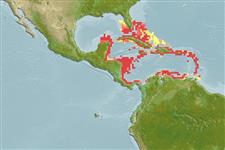Environment: milieu / climate zone / depth range / distribution range
Ecologia
marinhas; intervalo de profundidade 0 - 50 m (Ref. 189). Tropical; 28°N - 7°S, 90°W - 60°W (Ref. 189)
Western Central Atlantic: southern Florida (USA), Cuba, Bahamas, Greater and Lesser Antilles, and Yucatan, Mexico to Venezuela; not in Gulf of Mexico; Trinidad south to Guianas; possibly Brazil.
Tamanho / Peso / Idade
Maturity: Lm ? range ? - ? cm
Max length : 12.0 cm TL macho/indeterminado; (Ref. 5217); common length : 10.0 cm TL macho/indeterminado; (Ref. 5217)
Espinhos dorsais (total): 0; Raios dorsais moles (total): 14-15; Espinhos anais 0; Raios anais moles: 19 - 26. Somewhat compressed. Snout pointed, about 3/4 eye diameter; maxilla pointed, long, reaching to hind border of pre-operculum; walkeri-type gill cover canals. Anal fin origin below about midpoint of dorsal fin base. Anus advanced, nearer to pelvic fin tips than to anal fin origin. Silver stripe along flank with a dark line above, expanded over anal fin, about 3/4 eye diameter (Ref. 189). Back gray, top of head iridescent. Melanophores evenly scattered on back, forming a middorsal line, especially rearward (Ref. 7251).
Occurs in coastal waters, forming dense schools. Not entering the mangrove-lined lagoons of the Venezuelan mainland, but is the dominant species of the Los Roques Archipelago off Venezuela and there found as much in the lagoons as outside them. Frequently caught in mixed schools (with A. mitchilli) in the Miami area. Feeds on zooplankton. Ripe females recorded off Florida in June and July. More data needed.
Life cycle and mating behavior
Maturidade | Reprodução | Desova | Ovos | Fecundidade | Larvas
Spawn in school (Ref. 205).
Whitehead, P.J.P., G.J. Nelson and T. Wongratana, 1988. FAO Species Catalogue. Vol. 7. Clupeoid fishes of the world (Suborder Clupeoidei). An annotated and illustrated catalogue of the herrings, sardines, pilchards, sprats, shads, anchovies and wolf-herrings. FAO Fish. Synop. 125(7/2):305-579. Rome: FAO. (Ref. 189)
Categoria na Lista Vermelha da IUCN (Ref. 130435)
Ameaça para o homem
Harmless
Utilização humana
Pescarias: pescarias de subsistência; isco: usually
Mais informação
ReferênciasAquaculturaPerfil para aquaculturaEstirpesGenéticaElectrophoresesHereditariedadeDoençasProcessamentoNutrientsMass conversion
ColaboradoresFotografiasStamps, Coins Misc.SonsCiguateraVelocidadeTipo de nataçãoÁrea branquialOutras referênciasCérebrosVisão
Ferramentas
Relatórios especiais
Descarregue XML
Fontes da internet
Estimates based on models
Preferred temperature (Ref.
123201): 25.1 - 28.1, mean 27.5 °C (based on 112 cells).
Phylogenetic diversity index (Ref.
82804): PD
50 = 0.5000 [Uniqueness, from 0.5 = low to 2.0 = high].
Bayesian length-weight: a=0.00513 (0.00232 - 0.01135), b=3.14 (2.96 - 3.32), in cm total length, based on LWR estimates for this Genus-body shape (Ref.
93245).
Nível Trófico (Ref.
69278): 3.4 ±0.45 se; based on food items.
Resiliência (Ref.
120179): Elevada, tempo mínimo de duplicação da população menor que 15 meses (Preliminary K or Fecundity.).
Fishing Vulnerability (Ref.
59153): Low vulnerability (10 of 100).
